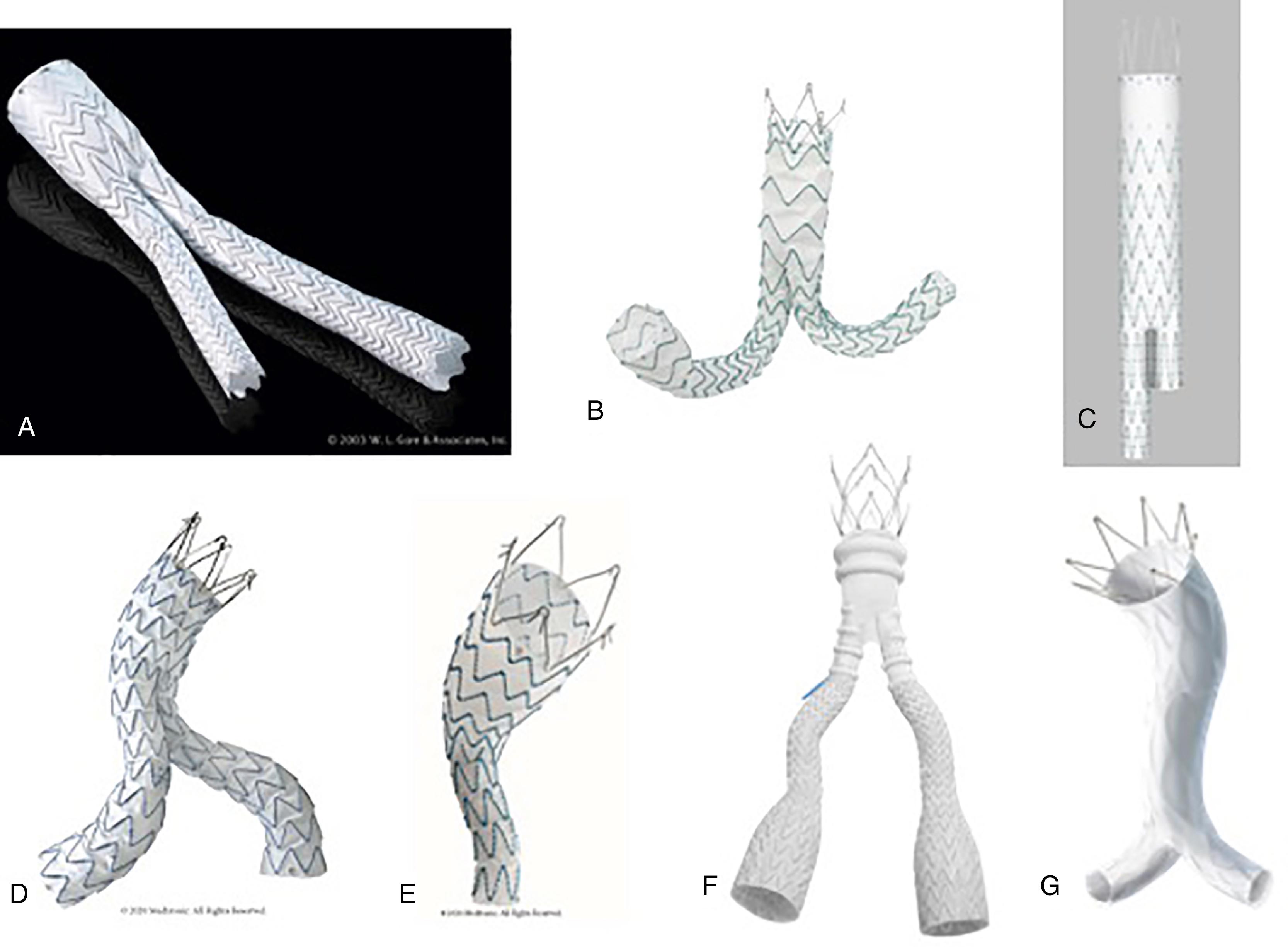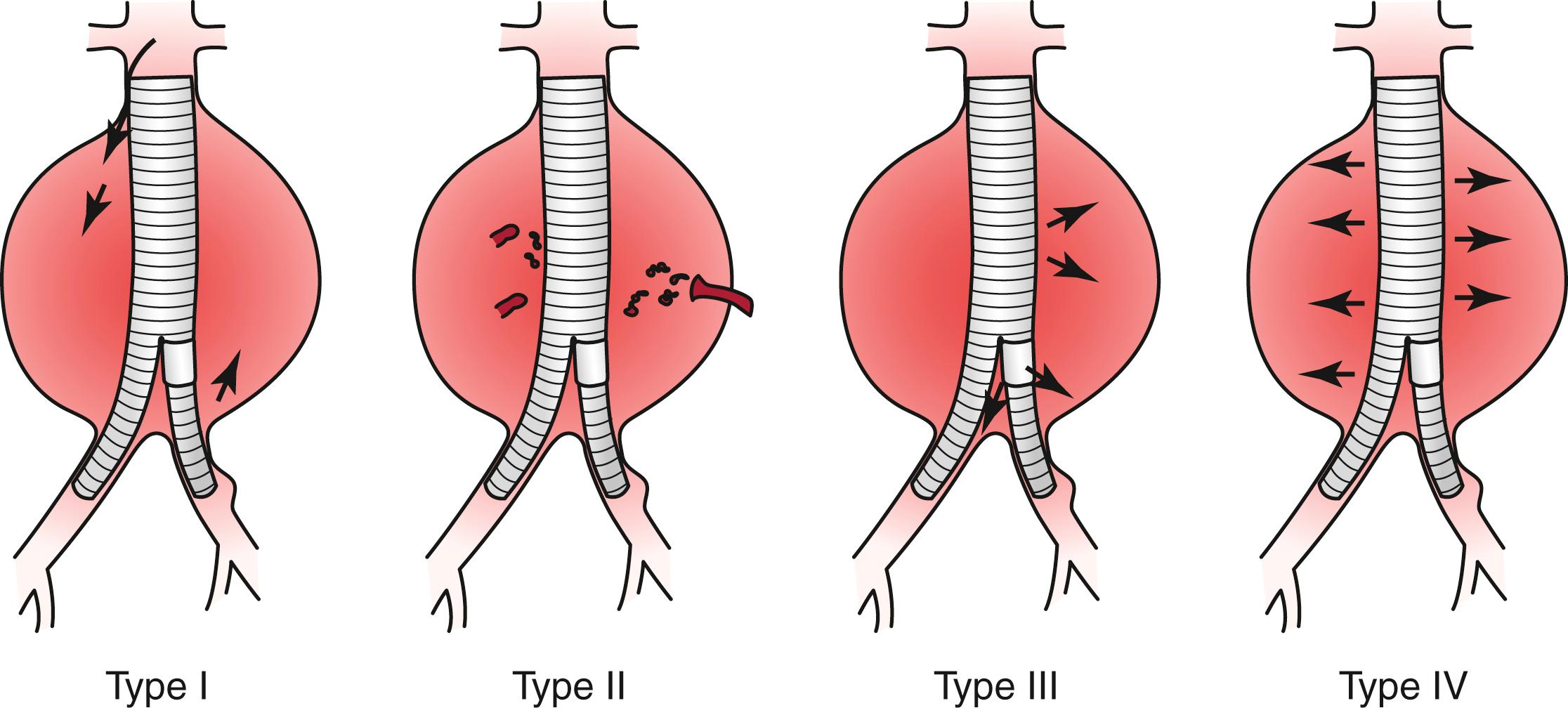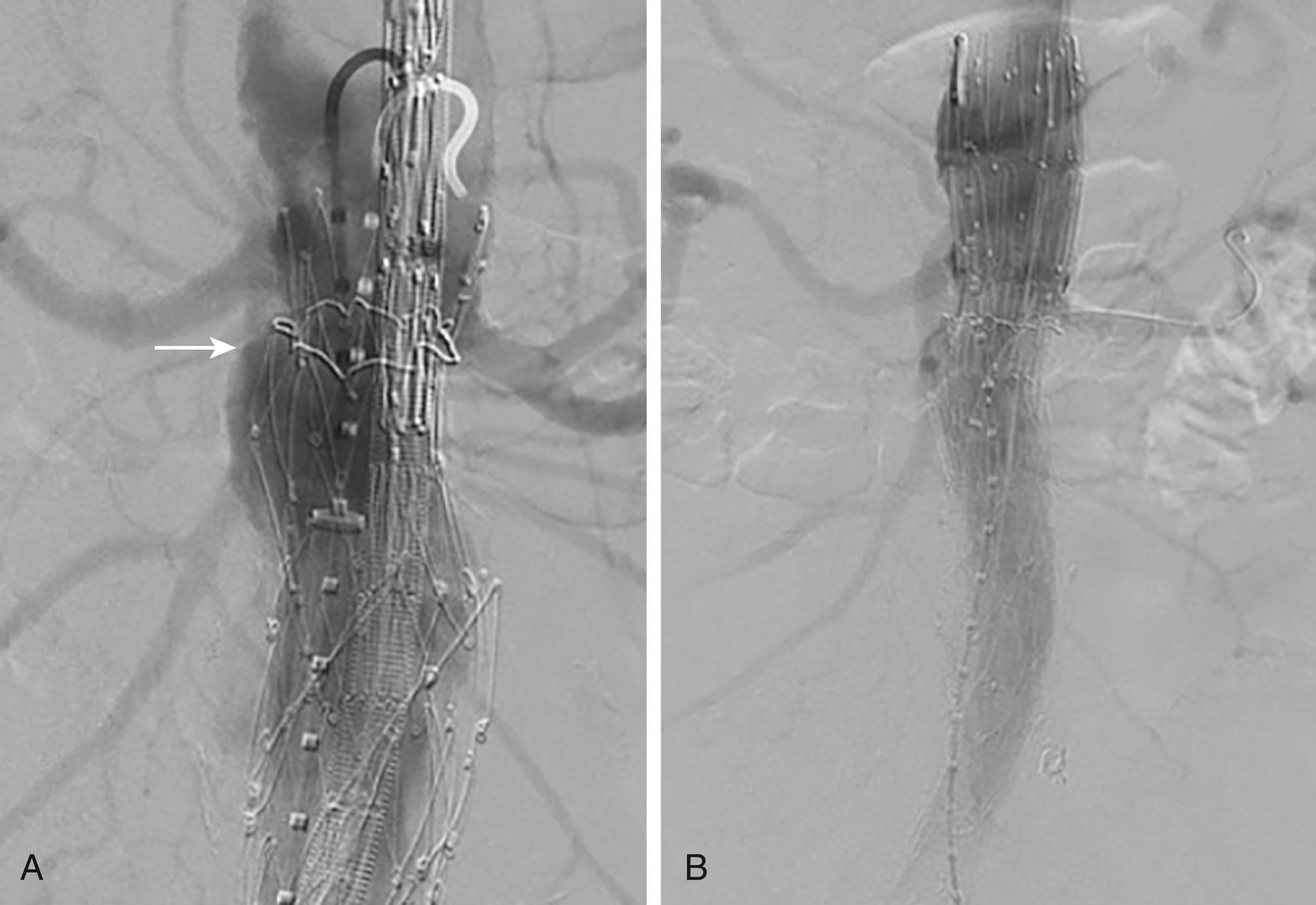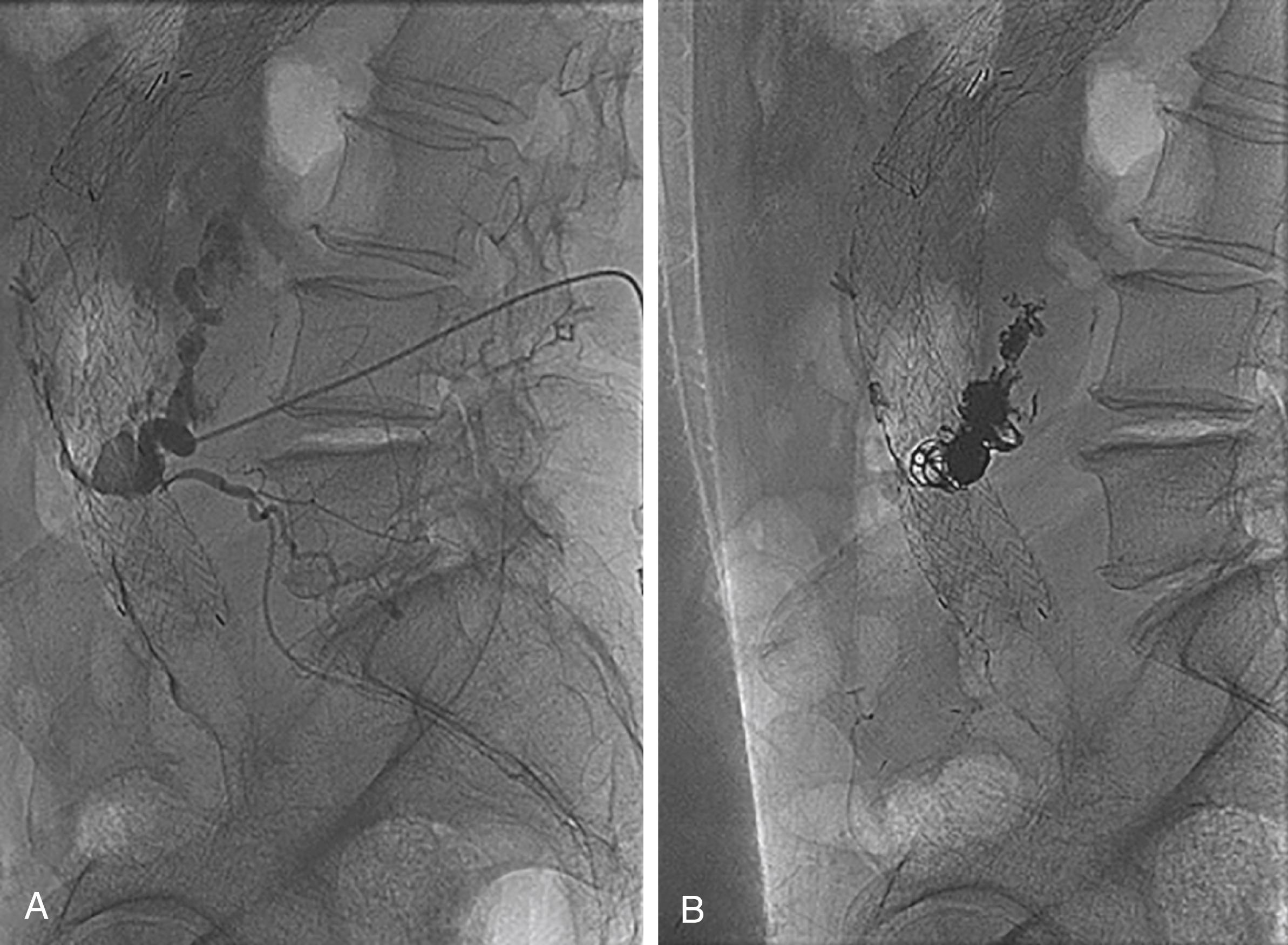Physical Address
304 North Cardinal St.
Dorchester Center, MA 02124
The first stent-based endoprosthesis with aortoiliac fixation was used in a human in May of 1985 to treat iliac artery stenosis. This technology was then used to treat aneurysmal disease in March of 1987, when a stent graft was delivered through the femoral artery to treat a post-traumatic pseudoaneurysm in the thoracic aorta. Four years later in 1991, Juan Parodi published his experience with deployment of a stent-anchored, Dacron prosthetic through the femoral arteries for treatment of abdominal aortic aneurysms. From that point on, the endovascular aneurysm repair (EVAR) revolution commenced. This chapter focuses on the outcomes of EVAR and their comparison with open surgical repair outcomes.
The initial aortic endografts were constructed by suturing a balloon-expandable stent to a standard Dacron tube graft. These grafts were limited to treatment of patients who had proximal and distal seal zones within the aorta. Different strategies were developed to treat aneurysms extending to the aortic bifurcation. Yusuf et al. described the use of an aorto-uni-iliac graft sutured to self-expanding stents in combination with a femoral–femoral bypass and occlusion of the contralateral iliac artery. In 1993, the unibody bifurcated aorto-bi-iliac stent was developed and the modular bifurcated design quickly followed. Early studies investigating these methods concluded that the aorto-uni-iliac and bifurcated configurations had a lower incidence of both early and late endoleaks when compared with tubular aortic configurations. These modular configurations rapidly became the design of choice for modern endografts. Regulatory approval for the abdominal aortic stent graft occurred in 1996 in Europe and subsequently in the United States in 1999. Early graft designs brought with them notable problems with the emerging technology. In September of 1999, the FDA approved two grafts for the treatment of AAA, the Guidant Ancure device (Indianapolis, IN) and the Medtronic AneuRx graft (Minneapolis, MN). The Guidant Ancure consisted of a Dacron graft supported only at the proximal and distal fixation sites. While there was early success with this device, notable problems were observed with both the delivery system as well as with attachment site hook fractures. , A high incidence of iliac limb stenoses and occlusions were also seen and attributed to the graft limbs being unsupported by stents.
The original AneuRx graft (Medtronic, Minneapolis, MN), although well received because of its innovative ease of deployment and smaller profile, was plagued with a higher migration rate. This endograft underwent a series of modifications but was ultimately discontinued in favor of newer grafts. Early grafts were also prone to type IV endoleaks for a variety of reasons, including fabric tears caused by fatigue erosion of the stents against the material. This observation led to the secure suturing of stents to the fabric to prevent excessive motion over time. The initial Excluder graft (W.L. Gore, Flagstaff, AZ) had a propensity for type IV endoleak due to fabric porosity, resulting in development of their next generation low-porosity fabric which was used in future designs and resulted in an improved rate of aneurysm sac shrinkage. Failures in early endografts led to improvement in all areas of graft design including graft material, delivery systems, stent design and composition, and method of securing the stent to the graft material.
The modern version of stent-graft design is a bifurcated graft, most commonly using a modular system to allow for the most flexibility with regard to patient anatomy. Currently, seven FDA-approved endografts are commercially available for the treatment of infrarenal AAAs in the United States ( Fig. 75.1 , Table 75.1 ). Each device has some unique features that are intended to result in improved outcomes. Most current stent-graft designs have favored suprarenal stents to inhibit downward migration, the development of type I endoleak, and endograft failure. The AFX device is the only one that touts passive fixation, whereby the flow divider of the stent graft sits directly on the aortic bifurcation. Most devices require at least 10 mm of proximal seal zone. However, the Endurant II and IIs grafts are approved for treatment of 4 mm neck lengths with the use of the Heli-FX™ EndoAnchor™ system. The C3 delivery system for the Gore Excluder graft allows for the ability to reposition the graft through the use of a constraining dial which allows for proximal trunk reconstraining and reopening. The only current FDA approved aorto-uni-iliac device for the treatment of infrarenal AAA is the Endurant II AUI device. The Zenith Renu is an aorto-uni-iliac device indicated for treatment of patients who have undergone prior EVAR but have an inadequate proximal seal. The two newest FDA-approved devices are the Ovation Alto (Endologix, approved March 2020) and the Treo (Terumo Aortic, approved May 2020). The Ovation Alto offers several design changes on the original Ovation, including relocation of the sealing ring closer to the edge of the fabric.

| Device Name | Company | Proximal Neck IFU | Iliac IFU | Fabric | Metal | Active Fixation | Notes |
|---|---|---|---|---|---|---|---|
| AFX2 | Endologix | Length: 15 mm Diameter: 18–32 mm |
Length: 15 mm Diameter: 10–23 mm |
Duraply | Cobolt chromium alloy | Deployment at aortic bifurcation | |
| Alto | Endologix | Length: 7 mm Diameter: 16–30 mm |
Length: 10 mm Diameter: 8–25 mm |
ePTFE | Nitinol | Suprarenal stent with barbs and infrarenal sealing rings | Custom sealing polymer ring |
| Endurant II/ Endurant IIs | Medtronic | Length: 10 mm∗ Diameter: 19–32 mm |
Length: 15 mm Diameter: 8–25 mm |
Woven Polyester | Nitinol | Suprarenal stent with barbs | ∗Indicated for 4 mm neck with the use of endoanchors |
| Endurant II AUI | Medtronic | Length: 10 mm∗ Diameter: 19–32 mm |
Length: 15 mm Diameter: 8–25 mm |
Woven Polyester | Nitinol | Suprarenal stent with barbs | ∗Indicated for 4 mm neck with the use of endoanchors, Aorto-uni-iliac device |
| Excluder | Gore | Length: 15 mm Diameter: 19–32 mm |
Length: 10 mmDiameter: 8–25 mm | ePTFE | Nitinol | Infrarenal barbs | |
| Incraft | Cordis | Length: 10 mm Diameter: 17–31 mm |
Length: 15 mm Diameter: 7–22 mm |
PET | Nitinol | Suprarenal stent with barbs | Not currently marketed in the US |
| Treo | Terumo Aortic | Length: 10 mm (<60° angle and diameters 17–32 mm) Length: 15 mm (60–75° angle and diameters 16–30 mm) |
Length: 10 mm (diameters 8–13 mm) Length: 15 mm (diameters 13–20 mm) |
Woven Polyester | Nitinol | Suprarenal stent | |
| ZenithFlex | Cook | Length: 15 mm Diameter: 18–32 mm |
Length: 10 mm Diameter: 7.5–20 mm |
Woven Polyester | Stainless steel Cook-Z® stent | Suprarenal with barbs |
With the advent of smaller delivery systems, percutaneous technique has been used, decreasing the morbidity of the procedure even further. The most common vascular closure device used for percutaneous EVAR is the Perclose Proglide (Abbott, Abbott Park, IL) which consists of a pre-tied Prolene suture, and can accommodate a 5- to 8-Fr arteriotomy with one suture and an 8.5- to 24-Fr arteriotomy with two sutures. For arteriotomies greater than 8 Fr in size, the “preclose technique” is required. The vast diameters treatable with the Perclose Proglide make it a popular choice in performing percutaneous EVAR. The predictors for failure of the technique include small access vessel diameter and anterior wall calcification. Therefore, the role of ultrasound-guided access when contemplating the use of vascular closure devices is crucial. The use of this technique has a 94% success rate with only 1.6% of the complications requiring open surgery. Additionally, the use of this technique has resulted in a decreased complication rate and hospital length of stay, making it an extraordinarily useful technique given appropriate anatomy.
EVAR-1 was a randomized prospective UK study including 1082 patients that compared EVAR with open AAA repair in patients who were fit enough to undergo open surgical repair from 1999 to 2003. The 30-day mortality rate was reduced in the EVAR group (1.7% vs. 4.7%), although secondary interventions were more common (9.8% vs. 5.8%). The DREAM trial was a multicenter randomized trial (enrolling from 2000 to 2003) that compared open repair with EVAR in 345 patients, and found a reduction in operative mortality in EVAR patients (1.2% vs. 4.6%) as well as reduction in the combined rate of operative mortality and severe complications (4.7% vs. 9.8%). The Open Versus Endovascular Repair (OVER) trial including 881 patients from 42 VA centers randomized to either EVAR or open repair demonstrated that perioperative mortality was improved in the EVAR group (0.5% vs. 3.0%), yet no difference was seen in mortality at 2 years (7.0% vs. 9.8%). The Anevrisme de l’aorte abdominal: Chirurgie versus Endoprosthese (ACE) trial compared EVAR with open surgical repair in low- to moderate-risk patients. In-hospital mortality and the incidence of postoperative complications were not statistically different. In addition, with a median follow-up of 3 years, no difference was observed in survival or the incidence of major events.
Although the results from the EVAR-1, DREAM, and OVER trials rather conclusively demonstrate the improved perioperative morbidity and mortality profile of EVAR compared with open aortic aneurysm repair, concerns remain over the long-term durability and survival benefit of EVAR. The OVER trial long-term results revealed that, although the perioperative advantage of EVAR was still realized at 3 years, survival was similar between groups beyond this time. EVAR-1 trial 15-year outcomes demonstrate that, after 8 years, open repair has both a lower all-cause and aneurysm-related mortality than EVAR. The DREAM trial showed no difference in mortality between the EVAR and open groups during 12 years of follow-up, although the freedom from re-intervention was higher in the open group when compared to EVAR (78.9% vs 62.2%). Evaluation of 15-year outcomes from the EVAR-1 trial demonstrate that, after 8 years, open repair has both a lower all-cause and aneurysm-related mortality than EVAR.
Although long-term outcomes do not seem as favorable as the perioperative outcomes when comparing EVAR to open repair, it is important to remember that there have been many advances in stent-graft technologies since the early trials. A comparison between newer stent grafts and those that are off the market reveals a striking difference regarding rates of migration, rupture, conversion, and re-intervention. , A recent meta-analysis demonstrated higher all-cause mortality, secondary rupture, and re-intervention in EVAR when compared to open repair at 5–9 years; however, subanalysis of more recent studies demonstrated no difference in long-term mortality.
The success of EVAR is highly dependent on the patient’s anatomic suitability for the procedure. Factors that determine anatomic suitability include neck diameter, neck length, and angulation. A US-based study of 10,228 patients who underwent EVAR from 1999 through 2008 demonstrated that only 42% of patients met the most stringent criteria for instructions for use, whereas 69% met a more liberal definition of instructions for use, and that the 5-year rate of sac enlargement after EVAR was 41%. A single-center retrospective cohort study shows a 43.8% rate of adherence to IFU in a population of patients requiring late conversion to open surgery after EVAR, compared to a 79% rate of adherence to IFU in the overall cohort. Furthermore, long-term follow-up of EVAR patients has been inconsistent, a cause for concern given the not infrequent need for secondary interventions in the mid to long term. A study of 19,962 Medicare beneficiaries undergoing EVAR from 2001 to 2008 showed that 50% of patients were lost to annual imaging follow-up at 5 years after surgery.
In general, institutional series are reported by academic centers with a high level of expertise and controlled, prospective, multicenter studies reflect the beneficial effects of rigorous patient and investigator selection. Therefore, statewide and nationwide audits may provide a more accurate clinical picture, although procedure-specific information may be sparse because the study is usually based on administrative data. Studies of this kind have confirmed the short-term advantages of EVAR over open AAA repair. , This was further examined in a study of late survival with re-interventions and readmission after open and EVAR. Re-intervention and readmissions were more frequent after EVAR than after open repair (7.56 vs. 6.96/100 person-years), but the majority of these re-interventions were minor endovascular interventions. Notably, rupture was five times more common after EVAR compared with open repair, but with a relatively low rate overall. In the open repair group, as expected, laparotomy-associated re-interventions were more common and were associated with a mortality rate of 12.2%. The study concluded that survival was negatively impacted by re-intervention or readmission after EVAR or open surgery, which contributed to the loss of survival benefit of EVAR over time. Looking specifically at patients over the age of 65, a study of Medicare beneficiaries from 2003 to 2007 showed that open repair was associated with an increased risk of all-cause mortality and AAA-related mortality over a follow-up period of 5.7 years. Both short- and long-term mortality outcomes, as well as the higher re-intervention rate after EVAR, have been confirmed in more recent population-based studies. In an analysis of Medicare data from 2001 to 2008, the overall perioperative mortality rate was 1.6% for EVAR and 5.2% for propensity score-matched open surgical controls. However, late survival was similar between the two groups, although the survival curves did not converge until after 3 years. By 8 years, the EVAR group had more aneurysm-related interventions as well as a higher rate of aneurysm rupture while the open repair group had a higher rate of laparotomy-associated complications.
To date, there have been no medical therapies that have been effective in slowing the rate of AAA growth or preventing rupture. Therefore, most studies comparing EVAR to medical management have looked at patients with high operative risk. This question was addressed by the EVAR-2 trial, in which 338 patients who were unfit for an open repair were randomized to either EVAR or medical management. The aneurysm-related mortality and all-cause mortality rates were no different between groups. The 30-day mortality rate for EVAR was 9%, although 3.6% of these deaths were from rupture while awaiting EVAR, because the median time to intervention was 57 days. Furthermore, 25% of patients assigned to medical management eventually underwent EVAR either because of patient preference or surgeon preference, with a strikingly low mortality rate. Given the number of AAA ruptures in the EVAR group while awaiting surgery, as well as crossover of the medically treated patients to the treatment group, it is perhaps not surprising that no difference was seen in aneurysm-related or overall mortality between groups at 4 years. Long-term follow-up from the EVAR-2 trial shows no difference in life expectancy between EVAR and medical management, but a significantly lower aneurysm related mortality in the EVAR group. Despite its shortcomings, EVAR-2 correctly underscores the fact that very-high-risk patients may not benefit from AAA repair because they often die from other causes before a benefit can be realized. However, it appears that EVAR can be performed safely by experienced surgeons in carefully selected high-risk patients.
Although EVAR-2 is the only randomized controlled trial comparing EVAR to medical management in high-risk patients, other studies provide data on performing EVAR in high-risk patients. A retrospective study comparing high-risk and normal-risk patients undergoing EVAR from 2006 to 2013 found no difference in perioperative mortality or early complication rates, although the high-risk group had lower long-term survival rates, which was expected. Data from the Department of Veterans Affairs National Surgical Quality Improvement Program on high-risk veterans undergoing EVAR showed a 30-day mortality rate of 3.4% and a 1-year mortality rate of 9.5%, which was significantly reduced compared with open repair (5.2% and 12.4%, respectively). The Veterans Affairs large aneurysm study, which was an observational study of surgically unfit patients, showed a 1-year rupture rate of 9.4% for aneurysms measuring 5.5 to 5.9 cm, 10.2% for aneurysms 6.0 to 6.9 cm, and 32.5% for aneurysms measuring 7.0 cm or greater. A more recent literature review found yearly rupture rates of 3.5% for aneurysms 5.5 to 6 cm, 4.1% for aneurysms 6.1 to 7 cm, and 6.3% for aneurysms >7 cm, although this study was not limited to high-risk patients. Taken together, these data demonstrate that EVAR may be safely performed in patients who are deemed unfit for open repair, but may not offer a survival benefit. Decisions should be made on a case-by-case basis after extensive discussion with the patient.
Three separate multicenter randomized controlled trials have failed to show a mortality benefit for EVAR compared to open repair in ruptured AAA. The IMPROVE trial is a multicenter randomized clinical trial comparing EVAR to open repair in ruptured AAAs. Interestingly, there was no significant difference in 30-day mortality between EVAR and open repair groups (35.7% vs. 39.3%), although there was a fourfold decrease in mortality in the EVAR group amongst patients who received local anesthesia compared to those who received general anesthesia. Similar results were found in another randomized trial from Amsterdam (AJAX) with a 30-day mortality rate of 21% for EVAR and 25% for open repair, as well as one from France (ECAR) with a 30-day mortality rate of 18% for EVAR and 24% for open repair. All three studies have been criticized, with the AJAX and ECAR trials having small numbers and excluding high-risk patients, and the IMPROVE trial having a large amount of crossover between groups after randomization. A meta-analysis of studies comparing EVAR and open repair for ruptured AAA found improved mortality rates in EVAR in both hemodynamically stable (18.9% vs. 28.2%) and hemodynamically unstable (36.8% vs. 61.7%) patients. Additionally, a review of surgical registries from 11 countries has demonstrated a mortality benefit for EVAR over open repair in ruptured AAAs. Current SVS guidelines recommend the use of EVAR first in anatomically suitable candidates who present with ruptured AAA (see Ch. 76 , Ruptured Aortoiliac Aneurysms and their Management).
An endoleak is defined as persistent blood flow in the aneurysm sac following stent grafting. Endoleaks are categorized into five different types, which differ in etiology as well as treatment ( Fig. 75.2 ).

Type I endoleak is defined as persistent blood flow into the sac either from around the graft proximally (type IA) or distally (type IB). When recognized in the operating room, type I endoleaks are typically addressed by performing proximal device extension and/or bare metal stent deployment to buttress radial support in the neck, with or without renal artery snorkel/encroachment techniques to preserve renal artery blood flow. The Aptus EndoStapling System (Heli-FX, Aortic Securement System, Sunnyvale, CA), which uses screws to secure the stent graft to the aortic wall, may also be used to enhance the proximal seal. If the main body or trunk of the prior stent graft is too short for the deployment of a proximal extension, an aorto-uni-iliac device may be used, necessitating a femoral–femoral artery bypass and embolization of the contralateral proximal iliac artery with an occlusion device. The patency rate of femoral to femoral artery bypass done with aorto-uni-iliac stent grafting for treatment of aortic aneurysmal disease is high, with a primary patency at 54 months of 90.9% and assisted primary and secondary patency rates of 97.7% and 100% at 66 months. When type I endoleak is detected late, it is typically secondary to caudad migration of the stent graft or continued dilatation of the neck. A proximal extension may be deployed to achieve a proximal seal. If type I endoleak continues after proximal stent-graft extension or bare metal stent placement, embolization with glue and/or coils has been shown to be a useful adjunct in treating persistent type I endoleak in a few small series. A fenestrated graft may also be used to extend the seal zone to the juxtarenal and suprarenal aorta ( Fig. 75.3 ) (see Ch. 82 , Fenestrated and Branched Endograft Treatment of Juxtarenal, Paravisceral, Thoracoabdominal, and Aortic Arch Aneurysms: Device Selection and Technical Considerations). Some authors have described open surgeries without complete graft explant in the treatment of proximal type I endoleaks including an external wrap of the neck or an interposition graft from the infrarenal aortic neck to the endograft, although these techniques are not widely studied. , Distal common iliac artery dilatation with type IB endoleak can be treated with hypogastric artery occlusion and extension of distal seal to the external iliac artery or by use of a branched iliac device (Zenith or Gore). If the previously described maneuvers are not successful in fixing the endoleak, operative explant of the stent graft is necessary because of the high risk of rupture associated with type I endoleak.

Type II endoleak is defined as persistent sac filling from back-bleeding side branches (i.e., the inferior mesenteric artery, lumbar arteries, or middle sacral artery). Postoperative CT scans show type II endoleak in 10% to 20% of patients following EVAR. , In comparison with type I and type III endoleaks, type II endoleaks can have a relatively benign course, with as many as 80% resolving spontaneously within 6 to 12 months of stent-graft repair. Furthermore, the risk of aneurysm rupture due to a type II endoleak is small but has been shown to occur in certain cases. Multivariate analysis of the EUROSTAR data showed no association between type II endoleak and risk of aneurysm rupture or need for surgical conversion. A recent meta-analysis likewise demonstrated the rarity of aneurysm rupture with isolated type II endoleak. Therefore, typically type II endoleaks are not treated unless aneurysm sac enlargement is documented. Persistent type II endoleaks are usually associated with a large endoleak cavity, flow between inflow and outflow arteries, and large, patent inferior mesenteric and lumbar arteries. Embolization can be performed using coils or N-butyl cyanoacrylate glue. The transarterial approach can be undertaken to embolize the inferior mesenteric artery through the superior mesenteric artery via the marginal artery of Drummond. The transcaval approach has also been described, during which the aneurysm sac is punctured through the IVC using a TIPS needle to inject coils or thrombin into the aneurysm sac or the vessels causing the type II endoleak. The translumbar approach uses CT and fluoroscopy to directly puncture the aneurysm sac ( Fig. 75.4 ). Regardless of the approach, type II endoleaks physiologically behave like AV malformations, and embolization of the nidus of the endoleak alone is usually inadequate for complete treatment. It is critically important to ensure that flow is obliterated in the inflow and outflow vessels. Retroperitoneal endoscopic ligation of the lumbar arteries has also been described. If the previous interventions fail to be successful, and the aneurysm sac continues to enlarge, operative explant or direct ligation of the back-bleeding vessel via sacotomy is required. The Nellix Endograft (Endologix, Inc, Irvine, CA) was developed to combat type II endoleaks by using polymer to fill the aneurysm sac. Data from the first stage of the device trial revealed a high rate of migration, leading to a change in the IFU. The device is currently still undergoing investigational trials in the US.

Become a Clinical Tree membership for Full access and enjoy Unlimited articles
If you are a member. Log in here